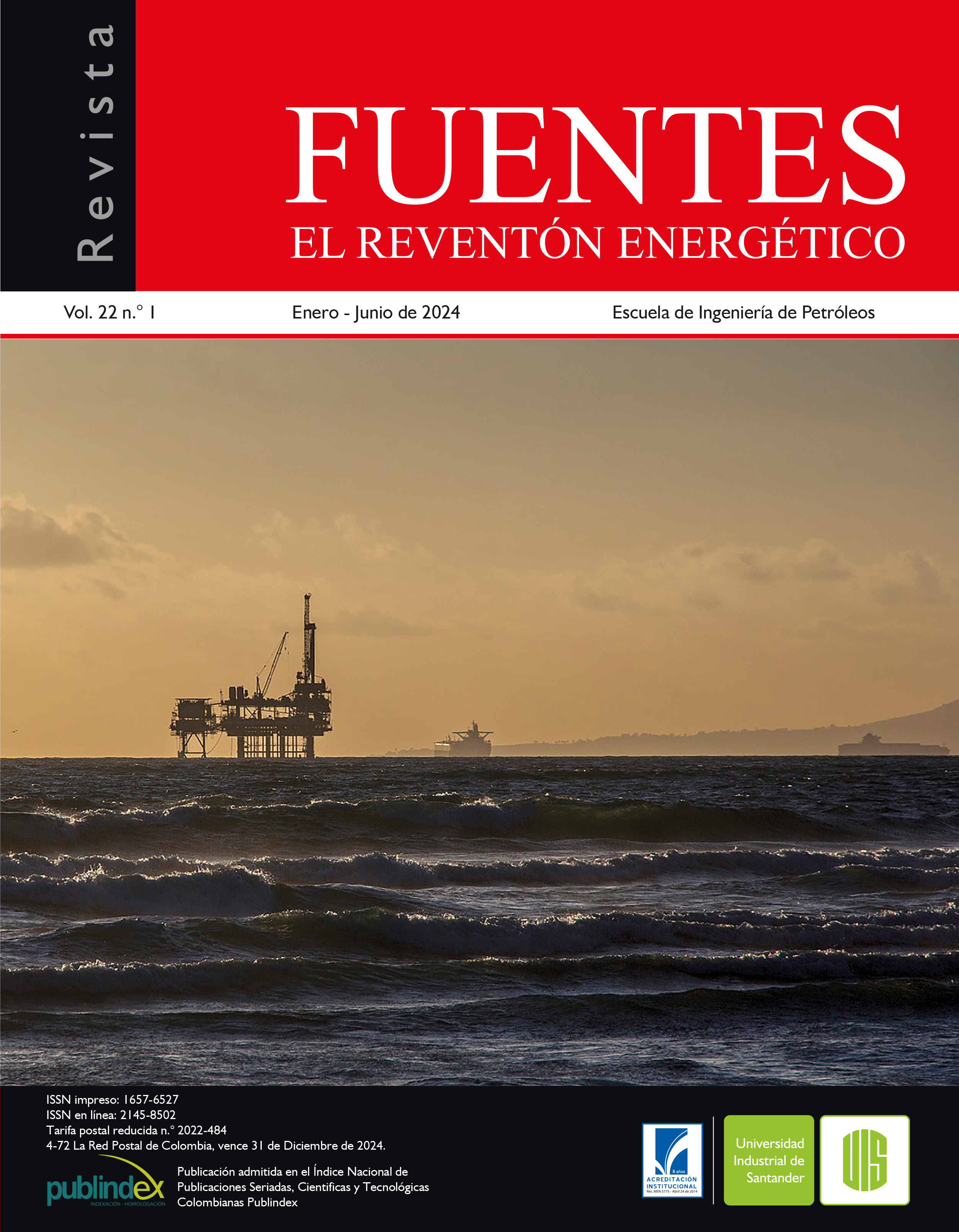TREATMENT OF PRODUCTION WATER ASSOCIATED WITH OIL APPLYING ELECTROCHEMICAL TECHNIQUES WITH MAGNESIUM METAL IONS
Published 2024-01-01
Keywords
- Produced Water,
- Sewage water,
- Electrocoagulation,
- Electrochemical,
- Magnesium
- Water Treatment,
- Petroleum,
- Electrolysis ...More
How to Cite

This work is licensed under a Creative Commons Attribution 4.0 International License.
Abstract
In this study, the electrocoagulation of the magnesium-magnesium electrode arrangement was used as anode and cathode in the
electrochemical technique for the treatment of production water associated with an oil field in Colombia. The use of magnesium
material in the electrodes is a different alternative to the materials normally used and applied in the oil industry, such as iron and
aluminum. Electrocoagulation as an electrochemical technique is a clean and emerging technology that has been applied since
the 21st century. The Magnesium ion electrocoagulation and electrodosification process was carried out with a change of polarity
with and without pH adjustment, applying a current density of 1 mA/cm2 for 25 minutes, finding a decrease in turbidity greater than 80%
Downloads
References
- Adhoum, N., & Monser, L. (2004). Decolourization and removal of phenolic compounds from olive mill wastewater by electrocoagulation. Chemical Engineering and Processing: Process Intensification, 43(10), 1281–1287. https://doi.org/10.1016/j.cep.2003.12.001
- Bravo Gallardo, M. A. (2017). Coagulantes y floculantes naturales usados en la reducción de turbidez, solidos suspendidos, colorantes y metales pesados en aguas residuales [Tesis de grado, Universidad Francisco José de Caldas]. Repositorio Institucional – Universidad Francisco José de Caldas.
- Meijer, D., & Kuijvenhoven, C. (2001). Field-Proven Removal of Dissolved Hydrocarbons from Offshore Produced Water by the Macro Porous PolymerExtraction Technology. All Days. https://doi.org/10.4043/13217-ms
- D.Th. Meijer; C.A.T. Kuijvenhoven. (2001). FieldProven Removal of Dissolved Hydrocarbons from Offshore Produced Water by the Macro Porous PolymerExtraction Technology. Offshore Technology Conference.OTC-13217- MS, Houston. Texas.https://doi.org/10.4043/13217-MS
- Dores, R., Hussain, A., Katebah, M., Adham, S. (2012). Using advanced water treatment technologies to treat produced water from the petroleum industry. International Production and Operations Connference and Exhibition. Society of Petroleum Engineers (SPE). Doha, Qatar. https://doi.org/10.2118/157108-MS
- Drewes, J., Cath, T., Xu, P., & Graydon, J. (2009). An Integrated Framework for Treatment and Management of Produced Water. Technical Assessment of Produced Water Treatment Technologies. RPSEA Project 07122-12. Colorado School of Mines. November, 8–128.
- El-Naas, M. H., Al-Zuhair, S., Al-Lobaney, A. & Makhlouf, S. (2009). Assessment of electrocoagulation for the treatment of petroleum refinery wastewater. Journal of environmental management, 91(1), 180-185. https://doi.org/10.1016/j.jenvman.2009.08.003
- Eyitayo, S. I., Watson, M. C., Kolawole, O., Xu, P., Bruant, R., & Henthorne, L. (2022). Produced Water Treatment: Review of Technological Advancement in Hydrocarbon Recovery Processes, Well Stimulation, and Permanent Disposal Wells. SPE Production & Operations, 38(01), 51-62. https://doi.org/10.2118/212275-pa
- Eyvaz, M. (2016). Treatment of Brewery Wastewater with Electrocoagulation: Improving the Process Performance by Using Alternating Pulse Current. International Journal Of Electrochemical Science, 11(6), 4988-5008. https://doi.org/10.20964/2016.06.11
- Fakhru’l-Razi, A., Pendashteh, A., Abdullah, L. C., Biak, D. R. A., Madaeni, S. S., & Abidin, Z. Z. (2009). Review of technologies for oil and gas produced water treatment. Journal of Hazardous Materials, 170(2-3), 530–551. doi:10.1016/j.jhazmat.2009.05.044
- García, L. E., Camargo, R. J., Marriaga, N. & Machuca, F. (2023). Tecnología emergente para el tratamiento de agua residual industrial asociada a la producción de petróleo pesado en un campo colombiano aplicando técnicas electroquímicas. ACIPET. Obtenido de https://congresoacipet.com/wpcontent/uploads/2023/09/TEC-373.pdf
- Garcia Rodríguez, L. E. & Gonzalez Guzman, L. G. (2022). Uso de la tecnología convencional para la reducción de agua de consumo y gases de efecto invernadero a través de la recirculación del agua residual no doméstica: Piloto Industrial en Colombia. Economía Circular. Revista Fuentes, el reventón energético, 20(2), 75-90. https://doi.org/10.18273/revfue.v20n2- 2022007.
- García Rodríguez, L. E. (2019). Aplicación de una técnica electroquímica para tratamiento de aguas de producción asociadas a yacimiento de petróleo pesado. Society of petroleum engineers (SPE). Water Managment.
- García Rodríguez, L. (2014). Aplicación de un proceso electroquímico para el tratamiento de aguas residuales de producción asociadas a yacimientos de petróleo liviano y pesado [Tesis de Maestría, Universidad del Valle].
- Ghanem, H., Rosiwal, S., Göltz, M., & Espin, D. (2016). Application of Electrochemical Treatment Technology of Produced Water of a Heavy Oil Field, via Boron Doped Diamond BDD Electrode. SPE Latin America and Caribbean Heavy and Extra Heavy Oil Conference. https://doi.org/10.2118/181178-MS
- Bande, R., Prasad, B., Mishra, I., & Wasewar, K. (2008). Oil field effluent water treatment for safe disposal by electroflotation. Chemical Engineering Journal, 137(3), 503–509. https://doi.org/10.1016/j.cej.2007.05.003
- Moussavi, G., Khosravi, R., & Farzadkia, M. (2011). Removal of petroleum hydrocarbons from contaminated groundwater using an electrocoagulation process: Batch and continuous experiments. Desalination, 278(1-3), 288-294. https://doi.org/10.1016/j.desal.2011.05.039
- Mesa, S. L., Orjuela, J. M., Ortega, A. T., & Sandoval, J. A. (2018). Revisión del panorama actual del manejo de agua de producción en la industria petrolera colombiana. Gestión y Ambiente, 21(1), 87–98.
- Mollah, M. A., Schennach, R., Parga, J. R., & Cocke, D. L. (2001). Electrocoagulation (EC) — science and applications. Journal Of Hazardous Materials, 84(1), 29-41. https://doi.org/10.1016/s0304-3894(01)00176-5
- Proaño López, W. (2019). El agua en el sector de petróleo y petroquímica: Usos y tratamientos [Tesis de Maestría, Universidad de Alcalá]. Biblioteca Digital Universidad de Alcalá.
- Rajeshwar, K. I. J. G., Ibanez, J. G., & Swain, G. M. (1994). Electrochemistry and the environment. Journal of applied electrochemistry, 24(11), 1077–1091. https://doi.org/10.1007/BF00241305
- Oficina Nacional de Administración Oceánica y Atmosférica (NOAA). USA. https://www.usa.gov/es/agencias/oficina-nacional-deadministraciono-ceanica-y-atmosferica.
- Verma, A. K. (2017). Treatment of textile wastewaters by electrocoagulation employing Fe-Al composite electrode. Journal Of Water Process Engineering, 20, 168-172. https://doi.org/10.1016/j.jwpe.2017.11.001
- Xu, X., & Zhu, X. (2004). Treatment of refectory oily wastewater by electro-coagulation process. Chemosphere, 56(10), 889-894. https://doi.org/10.1016/j.chemosphere.2004.05.003
- Younker, J., Lee, S. Y., Gagnon, G., & Walsh, M. E. (2011). Atlantic Canada Offshore R&D: Treatment of Oilfield Produced Water by Chemical Coagulation and Electrocoagulation. Offshore Technology Conference. doi:10.4043/22003-MS

